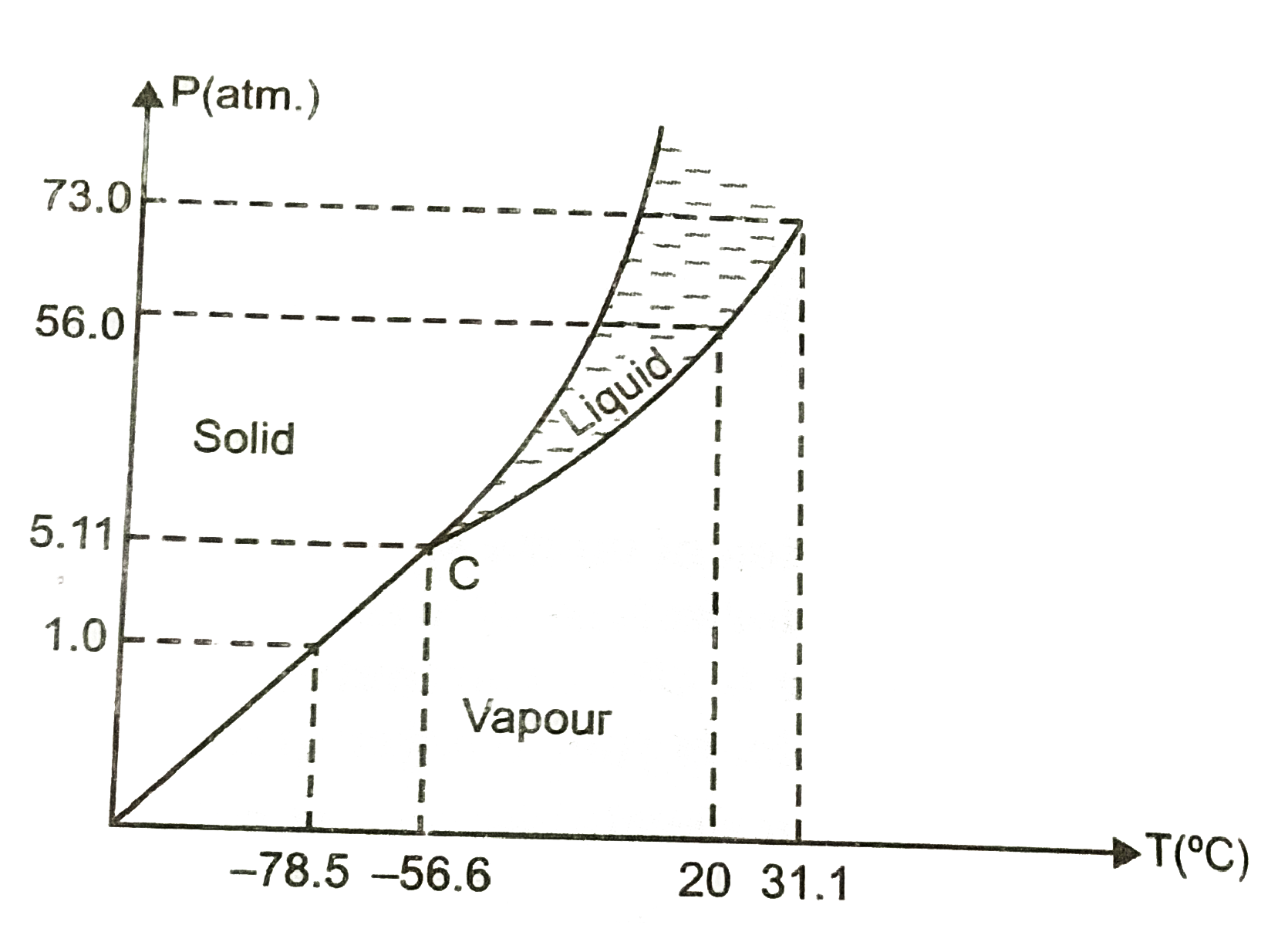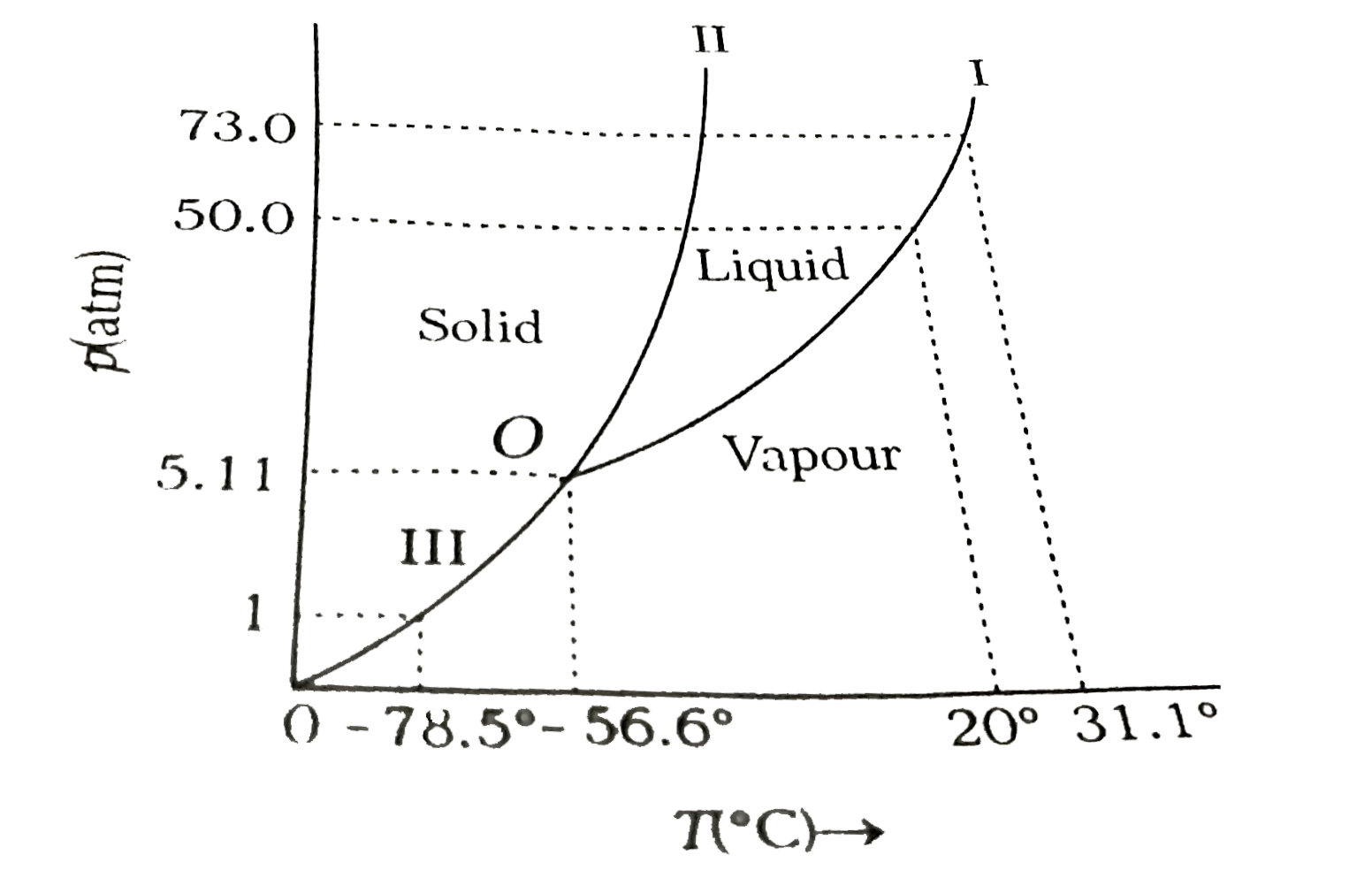Answer the following questions based on the P-T phase diagram of CO2 :
(a) CO2 at 1 atm pressure and temperature - 60∘C is compressed isothermally. Does it go through a liquid phase ?
(b) What happens when CO2 at 4 atm pressure is cooled from room temperature at constant pressure ?
(c ) Describe qualitatively the changes in a given mass of solid CO2 at 10 atm pressure and temperature- 65∘C as it is heated up to room temperature at constant pressure.
(d) CO2 is heated to a temperature70∘C and compressed isothermally. What changes in its properties do you expect to observe ?
(a) Since the temp- 60∘C lies to the left of 56.6∘C on the curve i.e. lies in the region of vapour and solid phase. So CO2 will condense directly into solid with out becoming liquid.
(b) Since the pressure 4 atm is less than 5.11 atm. The carbondioxide will condenses directly into solid without becoming liquid.
(c ) When a solid CO2 at 10atm. Pressure and −65∘C temp is heated, it is first converted into a liquid. A further increase in temperature brings it to the vapour phase. At P=10atm. If a horizontal line is drawn parallel to the T-axis. Then the points of intersection of this line with the fusion and vapourisation curve will give the fusion and boiling point of CO2 at 10atm.
(d) Since 70∘C is higher than the critical temperature of CO2. So the CO2 gas on being compressed isothermally at 70∘C. It will remain in the vapour state. Nowever the gas will depart more and more now its perfect gas behavious with the increase in pressure.
Similar Questions
Answer the following questions based on the P – T phase diagram of CO2:
(a) CO2 at 1 atm pressure and temperature–60∘C is compressed isothermally. Does it go through a liquid phase ?
(b) What happens when CO2 at 4 atm pressure is cooled from room temperature at constant pressure ?
(c) Describe qualitatively the changes in a given mass of solid CO2 at 10 atm pressure and temperature –65∘C as it is heated up to room temperature at constant pressure.
(d) CO2 is heated to a temperature 70∘C and compressed isothermally. What changes in its properties do you expect to observe ?
View SolutionOne mole of CO2 at 300 K and1 atm pressure is heated in a closed vessel so that temperature is 500 K is pressure is 5 atm. Then it is cooled so that temperature is 300 K and pressure is 1 atm. What is the change in internal energy of the gas ?
View Solution
Knowledge Check
What is the density of CO2 at 27.∘C and 2.5 atm pressure ?
A5.2gL−1B6.2gL−1C7.3gL−1D4.46gL−1What is the density of CO2 at 27.∘C and 2.5 atm pressure ?
A5.2gL−1B6.2gL−1C7.3gL−1D4.46gL−1When CO2 under high pressure is released from a fire extinguisher. Particles of soloid CO2 are formed, despite the low sublimation temperature (−77∘C) of CO2 at 1.0atm it is:
Athe gas does work pushingback the atmosphere using KE of molecuels and thus lowering the temperatureBvolume of the gas is decreased rapidly hence, temperature is loweredCboth a and bDnone of the above
Answer the following question beased on tbhe P-T phase diagram of carbon dioxide.

(a) At what temperature and pressure can the solid, liquid and vapour phases of CO2 co-exist is equilibrium ? (b) What is the effect of decrease of pressure on the fusion and bolling point of CO2 ? (c ) What are the critical temperature and pressure for CO2 ? What is their significane ? (d) Is CO2 solid, liquid or gas at (a) −70∘C under 1 atm, (b) −60∘C under 10 atm, (c) 15∘C under 56 atm ?
View SolutionAnswer the following questions based on the p-T phase diagram of carbon dioxide as shown in the figure .
(i) At what temperature and pressure can the solid , liquid and vapour phases of C02 co-exist in equilibrium?
(ii) What is the effect of decrease of pressure on the fusion and boiling point of C02 ?
(iii) What are the critical temperature and pressure for C02 ? what is their significance ?
(iv) Is C02 solid , liquid, or gas at (a) −70∘Cunder 1 atm (b) −60∘C under 10 atm (c) 15∘C under 56 atm ?

View SolutionAnswer the following questions based on the p-T phase diagram of carbon dioxide as shown in the figure .
(i) At what temperature and pressure can the solid , liquid and vapour phases of C02 co-exist in equilibrium?
(ii) What is the effect of decrease of pressure on the fusion and boiling point of C02 ?
(iii) What are the critical temperature and pressure for C02 ? what is their significance ?
(iv) Is C02 solid , liquid, or gas at (a) −70∘Cunder 1 atm (b) −60∘C under 10 atm (c) 15∘C under 56 atm ?

View SolutionAnswer the following questions based on the p-T phase diagram of carbon dioxide as shown in the figure .
(i) At what temperature and pressure can the solid , liquid and vapour phases of C02 co-exist in equilibrium?
(ii) What is the effect of decrease of pressure on the fusion and boiling point of C02 ?
(iii) What are the critical temperature and pressure for C02 ? what is their significance ?
(iv) Is C02 solid , liquid, or gas at (a) −70∘Cunder 1 atm (b) −60∘C under 10 atm (c) 15∘C under 56 atm ?

View SolutionThe critical temperature (Tc) and critical pressure (pc) of CO2 are 30.98∘C and 73 atm respectively. Can CO2(g) be liquefied at 32∘C and 80 atm pressure ?
View Solution
